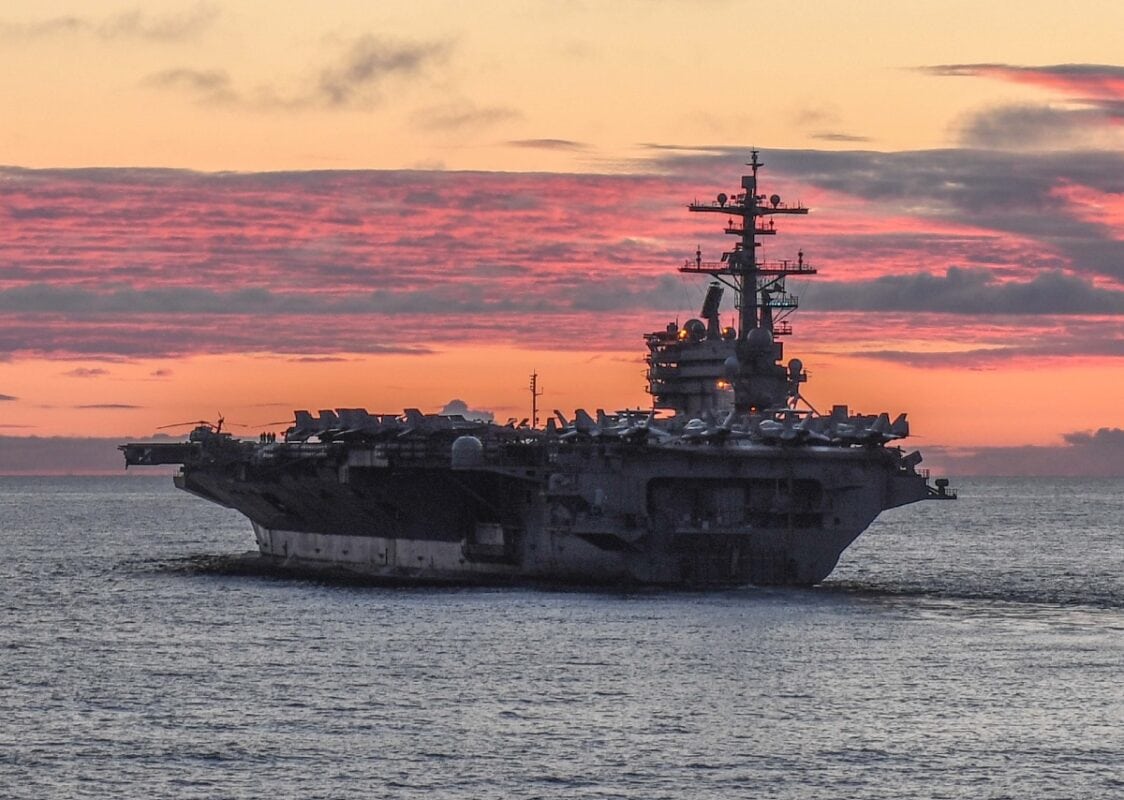The Very Best Aircraft Carrier in the U.S. Navy? We Vote for the USS George H.W. Bush: The USS George H.W. Bush (CVN-77) gets our vote for the best carrier in the U.S. Navy. The George H.W. Bush is the most modern and advanced flat-top of the improved Nimitz-class supercarriers. It was commissioned in 2009 and will serve until the 2050s. The George H.W. Bush is one of the most powerful aircraft carriers in the world. While the Navy looks forward to the first deployment of the USS Gerald R. Ford in autumn of this year, CVN-77 has already fielded the F-35C Lightning II and launched and recovered one of the stealth fighters in December.
An Aircraft Carrier Ode to a President
The Bush’s seal is inscribed by the P-3 Avenger torpedo bomber flown by President George H.W. Bush in World War Two. The Bush’s call sign is even “Avenger.” CVN-77 has a crew of over 6,000 with 2,500 sailors assigned to air operations. The $6.5 billion aircraft carrier has the admiral of the carrier strike group stationed aboard. It is nearly 1,100 feet long – about the size of three football fields. The Bush displaces 102,000 tons loaded with ammunition and supplies.
Carrier Wing Is Stout
CVN-77 usually deploys up to 56 airplanes including the F-35C, F/A-18A/C and F/A-18E/F, E-2C Hawkeye, and EA-18G Growler.
Fifteen helicopters are carried including the SH-60F, the HH-60H Rescue Hawk and the SH-60B Seahawk.
With four C13-2 steam catapults and three mk7 mod 3-type arrester cables, the carrier can launch and recover airplanes at the same time. The angled flight deck allows the ship to send out a different aircraft every 20 seconds.
Modern Arms Systems
The carrier has two to three GMLS mk29 missile launchers for the Sea Sparrow or Evolved Sea Sparrow missiles and two mk49 guided-missile launch systems for the RIM-116 rolling airframe missile. The Bush also comes with four 20mm Phalanx CIWSs (close-in weapon system).
Radar, Propulsion, and Bow Design Are Top-notch
CVN-77 has the latest radar and sensor suites. It is also fitted with an advanced electronic countermeasures system.
Propulsion is provided by two nuclear-pressurized water reactors. These drive four turbines and four shafts. It even has four back-up diesel engines.
The Bush has a bulbous bow design, this results in more buoyancy to the forward end of the carrier and enhances hull efficacy. Moreover, the flight deck has curved edges to lessen its radar signature. The advanced island has an improved radar tower. It sits further aft, so the flight deck has more room. This also diminishes radar signature.
CVN-77 has a modernized aviation-fuel storage and delivery system, semi-automated re-fueling and servicing to provide faster, more effective combat missions that need fewer crew members. It now has updated aircraft launch and recovery equipment.
Testing Drones and Socking It to ISIS
In 2013, CVN-77 launched and arrested an X-47B unmanned combat air system. This was the first carrier operations for the drone. In 2014, the Bush has been an important asset in operations against ISIS. Two F/A-18F Super Hornets dropped 500-pound precision-guided munitions on ISIS terrorists. This was followed by additional attacks by Hornets and Super Hornets against ISIS positions in Syria.
The Bush also tested the unmanned refueling aircraft called the MQ-25A Stingray in 2021. The Stingray has already practiced its refueling operations on the F-35C, F/A-18 Super Hornet, and the E-2D Advanced Hawkeye.
Maintenance Improved the Carrier
The Bush should be refreshed and ready for action again as it completed an extended 30-month period of maintenance last summer. The carrier got a shaft and propeller revamp, rudder renovation, modernization, and enhancements to its electronic and combat systems, plus work on its catapults.
The most significant development for the Bush is its coming addition of F-35C stealth fighters. The F-35Cs will increase warfighting capability and enable the Bush to project more power and deter adversaries.
Ready to Deploy
Homeported at Naval Station Norfolk, Virginia, the Bush will continue to be the muscle behind deployments to the Persian Gulf. It can perhaps support NATO operations in Europe and deploy to the Mediterranean for a show of force.

170808-N-FP878-008
ATLANTIC OCEAN (Aug. 8, 2017) The Arleigh Burke-class guided-missile destroyer USS Donald Cook (DDG 75) maneuvers between the Ticonderoga-class guided-missile cruiser USS Philippine Sea (CG 58), left, and the Nimitz-class aircraft carrier USS George H. W. Bush (CVN 77), right, for a photo exercise during exercise Saxon Warrior 2017, Aug. 8. Saxon Warrior is a United States and United Kingdom co-hosted carrier strike group exercise that demonstrates allied interoperability and capability to respond to crises and deter potential threats. (U.S. Navy photo by Mass Communication Specialist 1st Class Theron J. Godbold /Released)
It is interesting that the George H.W. Bush is serving as a testing platform for drones. This shows the navy has full confidence in its flight deck operations for modern aircraft. This trust, coupled with the F-35C, will make it a mainstay as the best carrier for the navy’s strategy and tactics lasting into the 2050s. The newer Gerald R. Ford will have competition.
Now serving as 1945’s Defense and National Security Editor, Brent M. Eastwood, PhD, is the author of Humans, Machines, and Data: Future Trends in Warfare. He is an Emerging Threats expert and former U.S. Army Infantry officer. You can follow him on Twitter @BMEastwood.

